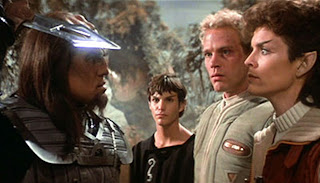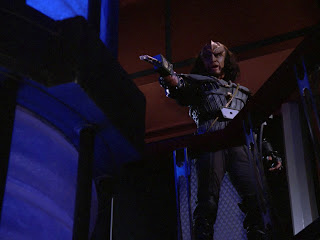Looking at the Klingon Civil War Part I
Origional Airdate: Week of March 21, 1988
Directed by: Rob Bowman.
Teleplay by: Maurice Hurley
Story by: Herbert Wright and D.C. Fontana
 |
| The Talarian Freighter Batris. . . |
The teaser opens with Starfleet ordering Enterprise to investigate a battle in the Romulan Neutral Zone. The Romulans haven’t been seen for decades at this point, and there shouldn’t be anyone traveling through the Neutral Zone at all; a situation that Picard and Riker agree feels like a trap. With all the times that that Trek characters blunder into traps, they should know the warning signs.
The ship isn’t a trap, though. It’s a damaged freighter on the verge of blowing itself apart, and killing the three life forms Enterprise detects aboard. Riker, Data and LaForge beam over to the to the damaged ship to investigate. I really love the set design for the damaged freighter. Its smokey, unevenly lit with emergency floodlights, and really gets across the idea that this ship is going to fly apart at any moment. This ship feels dangerous.
What I don’t like, though, is the ‘visual acuity transmitter’ attached to LaForge’s visor. The idea behind the device is solid, it makes sense that away teams would stream video to their ship during missions; but Geordi’s 24th century marvel streams video far worse than the average iPhone does from inside a tunnel. In the middle of the desert. On the moon. On AT&T.
This is a great idea that’s executed poorly. I’ve always wondered why there aren’t technicians on the bridge pouring over an away team’s tricorder data during critical missions. Streaming live video directly to the bridge would allow missions to draw on the collective experience of the entire senior staff. Think about how much time has been wasted
 |
| . . .is a deathtrap. |
describing to Picard what something looks like, and just imagine how much more information the team could collect if Picard could just see it for himself.
Geordi’s transmitter cuts out, and the team finds the survivors: Three Klingon warriors. In hindsight, its telling that during the entire away mission, the team never sees the bodies of the ship’s crew. This really should have probably been the first sign that something was very wrong aboard that freighter--maybe a technician studying tricorder data on the bridge would have come to that conclusion.
Lt. Yar transports the away team and the Klingon survivors back to the Enterprise, which is...odd. Why is the security chief handling a difficult transport instead of a specialist? What’s Chief O’Brien doing, and why is it more important than this mission? Maybe it would have been a better idea to have the tactical officer on the bridge while they’re still in the Romulan Neutral Zone? Or how about having her look into the obviously false cover story the Klingons tell once they’re taken to sickbay?
Instead, Worf is given the job of escorting the Klingons--except for the youngest, who is critically injured--to their quarters; beginning the segment of the Episode I like to call:
Lt. Worf Has Terrible Judgement!
In their quarters, Commander Korris and Lieutenant Konmel, the two uninjured survivors, dick around with Worf for a while--which seems only way that Klingons are able to interact with Worf--and decide that he’s is one of them. Before the three can bond over horrifying food, the third survivor, Kunivas, takes a turn for the worse, and Dr. Crusher calls them back to sickbay. Moments after Worf and his new KBFs (Klingon Buddies Forever) arrive in sickbay, Kunivas seizes and dies.
This is the first time we see the Klingon death ritual, which is touching in a weird way. Korris forces the dead man’s eyes open, glares into them, and begins to growl. This growling is apparently a sign for all other Klingons present to throw their heads skyward and bellow at the top of their lungs. This yelling is a warning to the dead: Beware, a Klingon warrior is coming.
Being aboard a space ship means that ‘skyward’ really has no meaning--the Klingons really have no way of knowing how Enterprise’s axes correspond to those of Qo’nos, and by extension, its afterlife Bearing that in mind, I like to imagine that they’re unwittingly screaming at Mecca. I don’t know why, it just makes me smile. Korris tells Picard to dispose of the body however he sees fit, because now it is just an empty shell; but not before obviously and suspiciously removing a piece of his dead comrade's boot and slips it into his pocket.
As Worf escorts Korris an Konmel back to their quarters, the two dig into Worf’s past. One of the finest character arcs that The Next Generation ever attempted was that of Worf. Worf’s backstory as an orphan and refugee made him among the richest, most complex characters in the entire franchise. Everything Worf is, and everything he will become is a logical progression from the moment Romulans attacked Camp Khitomer. We’ll explore how this all relates to the Klingon Civil War over the next several episodes, but suffice to say, the Klingon Empire’s salvation from itself rests almost entirely on the death of Worf’s family and his upbringing by Humans.
In their stateroom, the Klingons, including Worf, discuss honor and glory. They lament the softening of the Empire, which is, to them, the consequence of its alliance with the Federation. In embracing piece, they argue, the Empire has lost its way. Worf, they claim, has the mark of a warrior because his Klingon nature is constantly at war with his sense of duty to the Federation, and it’s not hard to agree.
 |
| I'm sure this won't bite us in the ass later |
Korris and Konmel finally admit to Worf--either because they now feel that he is a kindred spirit, or to manipulate him, or possibly both--that they had hijacked the Talarian freighter, hoping to find a place that they could live as Klingons; and used it to destroy a Klingon warship. Admittedly, that they were able to blow up a ship in a freighter is pretty damn impressive. Hell, that’s a feat even Dukat couldn’t manage.
Worf, having terrible judgement, agrees to take them on a tour of the most sensitive areas of the ship; including main engineering and the emergency turbolift to the battle bridge. Worf agrees to do this literally thirty-one seconds after the two admit to murdering a ship full of Klingons. I’d give him more shit about this, but the security department is going to screw up even worse in just a few minutes.
Sensors pick up a Klingon battlecruiser on an intercept course with Enterprise, to everyone’s shock, which is kind of weird. At this point, the Klingon Empire has been an economic and trade ally for nearly twenty years at this point. Riker, particularly, shits a brick at the sight of the Klingon ship, but what, exactly is he worried about? Jesus, Commander, act like you’ve got a pair.
Speaking to the ship’s commander, a man named K’nera, Picard learns what he should have figured out hours ago: the Klingons he rescued are criminals and renegades. Picard orders the two confined to the brig, and, to be fair to the security team, this is the one time in the series that security arrives in force, deploying no less than five armed guards so that they can easily overwhelm the criminals should they choose to resist.
A little girl wonders out of a turbolift with her mother, and for a moment it looks like the Klingons are going to take the child hostage. As the two are being lead away to a holding cell, however, Worf insists that there was never any danger, because Klingons don’t take hostages.
That’s true, never in the history of Star Trek to this point have Klingons ever taken a hostage:
 |
| Technically a Kidnapping |
 |
| High-Risk Negotiations with Unwilling Parties |
 |
| A Forced Religious Retreat |
 |
| A Rescue Mission that Got Out of Hand |
Enterprise’s Security Officers Have Terrible Judgement!
After impressing us a genuine show of force, security now feels obliged to remind us how utterly, laughably, disastrously incompetent they really are. The two Klingon prisoners are taken to a holding cell--this is the first incarnation of the brig, by season three there will be an actual cellblock style that will at least present the illusion of being a real jail, but for now:
So, what we got here, see, is the jail of the future. So secure, the door is left open. So escape-proof that the guards can stand in the corridor facing away from their prisoners. The design is so foolproof, that you don’t even have to search the prisoners! Let them sit there in their own clothes--or armor, in the case of Klingons--and count the money you’ll be saving!
Somehow, the Klingons escape Starfleet Supermax and kill two security guards in their escape. Konmel is killed in the firefight, but Korris is able to make his effortless way to main engineering; a location, you’ll remember, that was on Worf’s trademark Super-Duper Security Risk Starship Tour.
 |
| This doesn't count. Technically, the starship is the hostage |
The Klingon makes his way to engineering’s upper deck, points his disruptor at the warp core and demands to be given Enterprise’s battle section so he and Worf can fly around the universe, presumable to kill Romulans and teaching blue women how to love (fanfic writers, I expect twelve chapters by Friday).
Worf and Korris have a heart-to-heart with the warp core at gunpoint, we learn what it truly means to be a warrior (skipping over warriors NEVER taking hostages, because that’s just so obvious it doesn’t bear repeating), and then Worf kills Korris with a phaser.
Heart of glory isn’t a good episode. The best that can be said about it is that it’s the first to explore the Federation-Klingon Alliance, and just how much Klingons have been forced to change because of it. The visual effects are great; I especially loved the interior of the Batris and the odd camera angles around the warp core...although Korris falling through the transparent floor seems odd--why would you use actual fucking glass in engineering, rather than transparent aluminum?
Nerds (by which I mean, me) might have been annoyed that Lt. Yar saying that Korris was aiming directly at the dilithium chamber, when in fact he wasn’t:
 |
Data, sitting atop the real dilithium chamber,
Presumably voiding its warranty after a night of drinking |
This was a change in the script that moved the action to engineering’s upper deck from the main lobby, and I’m willing to give her a pass on that. I liked seeing the seldom-used upper deck, and it’s a pretty minor error--I’m sure shooting the warp core anywhere will result in a bad day.
The Good:
- The Klingon angst. It set up backstory that would trouble the empire throughout the rest of the franchise. Fo r all my teasing, I think that there's a very good reason for Worf's naïvety, which I'll talk about in the next episode.
The Bad:
- Heart of Glory makes Starfleet look like a collection of incompetent jackasses...uh, more than usual.
The Verdict:
- Go watch The Undiscovered Country instead.
©2013 AHoden or The Special Needs Group. Screen captures and TNG publicity photos property of their owners.
























